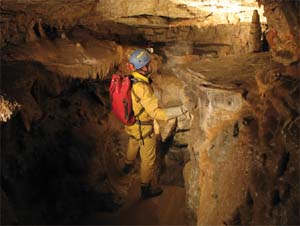A Spanish-Russian team of scientists has discovered four new species of arthropods in a cave in the region of Abkhazia near the Black Sea. One of these species is the world’s deepest-living land animal.

Plutomurus ortobalaganensi, the deepest-living terrestrial animal (University of Navarra)
The study, published in the Terrestrial Arthropod Reviews, describes the newly found species of arthropods, called Anurida stereoodorata, Deuteraphorura kruberaensis, Schaefferia profundísima and Plutomurus ortobalaganensi.
These four new species are springtails measuring between one and four millimeters. They belong to the Collembola group, arthropod invertebrates which are very numerous, and close to insects, arachnids and crustaceans.
The team collected them during the biospeleological works at different depths in the Krubera-Voronya Cave, the deepest known cave on Earth. Its deepest explored point is 2,191 meters.
These species are characterized by having an external skeleton and articulated appendages (limbs, antennae, etc.), in addition to a special organ for jumping, named the furcula.
Due to their living in a cave, they possess specific characteristics developed in order to survive in extreme subterranean conditions, such as the total absence of light and the scarcity of food resources.

The Krubera-Voronya Cave at -1,980 m, the deepest habitat of Plutomurus ortobalaganensis (Denis Provalov / the Terrestrial Arthropod Reviews)
“In response to these conditions, none of these animals have eyes, and lack pigmentation,” explained Dr. Enrique Baquero, a zoologist and a professor at the University of Navarra, Spain, and one of the authors on the study. “In addition, one of the species has developed a chemoreceptor – a kind of chemical parabolic antenna – which permits it to move in a such a complicated environment.”
One of the species, P. ortobalaganensi, is the deepest-living terrestrial animal known to date. It was encountered at the remarkable depth of 1,980 meters.
It ousts two species of worms (Halicephalobus mephisto and Plectus aquatilis), discovered at a depth of about 1,300 m in gold mines in South Africa, from the record for the world’s deepest-living land animal.
Dr. Baquero explained the presence of these arthropods in such a rugged environment: “They feed on the fungi that grow on it, contributing to its decomposition and participating in the network of stable communities of arthropods that exist in the caves.”







